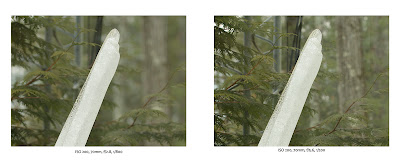 |
| An iPhone picture |
Technically, it features a couple of huge advantages. First, unlike my other zooms, its maximum aperture doesn't change as it zooms. It's a solid f/2.8 across the board. This gives me a full 2 stops more light through the lens when it's racked out to 200mm. Second, it has Nikon's latest generation vibration reduction technology (VR II) which lets me shoot without a tripod at much slower shutter speeds than would otherwise be possible. Nikon's marketing materials claim VR II allows you to hand-hold 4 stops slower than would be possible without VR II. Most of the reviews I've read contend that's pretty accurate.
Artistically, the difference in depth-of-field between f/2.8 and f/5.6 can be huge in a portrait or in wildlife photography. It enables the use of selective focus to guide the viewers eye into your photo. Since there was no chance of getting my usual model to sit still long enough to do a comparison shot, I used an icicle embedded in the snow on my deck to create an example instead.
The photo on the left was shot at f/2.8; on the right, f/5.6. In each case, I focused on the icicle. Notice how the shallower depth-of-field on the left causes the tree and antenna tower behind the icicle to go out of focus, making them less distracting. As you can see below, this effect can lead the eye to the most important part of a portrait: the eyes.
 |
| 165mm, ISO 800, f/2.8, 1/60 Exposure +1.00 in Lightroom |
NOTE: All of these were shot with ambient light, no flash. All have been adjusted for white balance in Lightroom. Any other post-processing tweaks are noted in the captions. And, as always, click on the image to see a larger version.
Even in a shot that is not framed as tightly as the one above, selective focus can draw the viewer to the eyes. The hand in the foreground is just enough out of focus that the viewer knows what it is without being distracted by it.
 |
| 120mm, ISO 1600, f/2.8, 1/60 |
 |
| 200mm, ISO 800, f/2.8, 1/60 Lightroom: Exposure +1.0, Fill +45, Noise Reduction +35 (most of the noise came from increasing fill in Lr and was not in the capture) |
 |
| 122mm, ISO 1600, f/2.8, 1/60 |

Great decision cz. Those are the same specs as my EF 70-200mm f/2.8 L IS II USM. I love it for all the reasons you mention and more. It does get heavy at times.
ReplyDeleteI keep seeing you mention Light Room. I may be going shopping again soon. But then I am also making my first Mac purchase next month (hopefully) after the new Macbooks come out. And I have been curious about Aperture. I need to talk with you in a few weeks for some serious MacCounseling.
I've heard good things about Aperture, and I know some first rate folks (like Joe McNally) use it. That said, Lightroom really does seem to be the gold standard and my only regret is that I didn't start using it earlier. I would tell you to run, don't walk, to download it. You can run it for 30 days without buying it. I guarantee it won't take that long to make you decide to buy a license.
ReplyDeleteDownloaded and reading Kelby's Lr3 book now - 466 pages to go.
ReplyDeleteVery nice images - and you're right, the technology does enhance your view of the subject. But if you hadn't included these examples, I might not have believed it was a lens. Looks more like a weapon! ;P
ReplyDelete